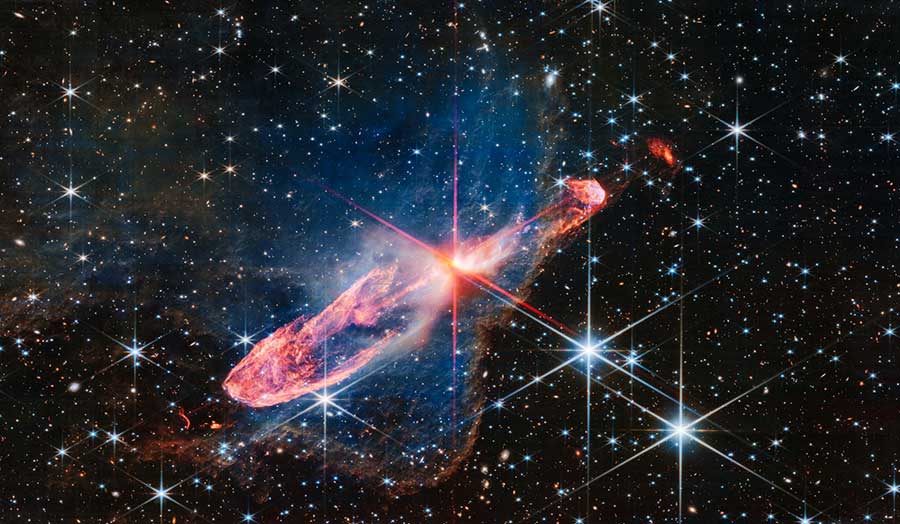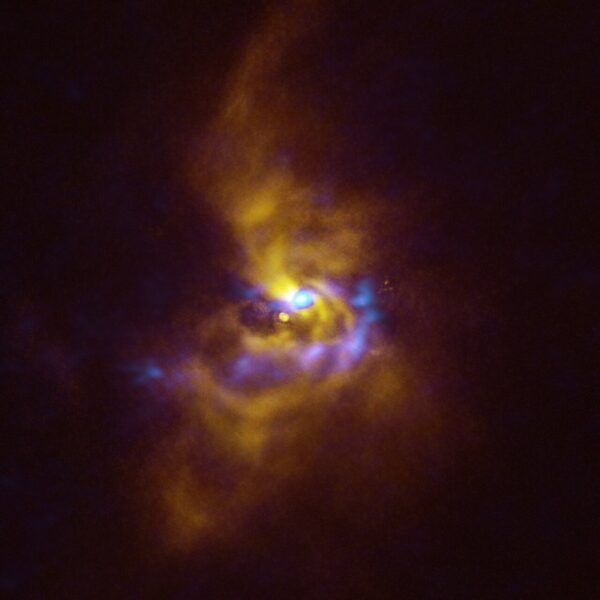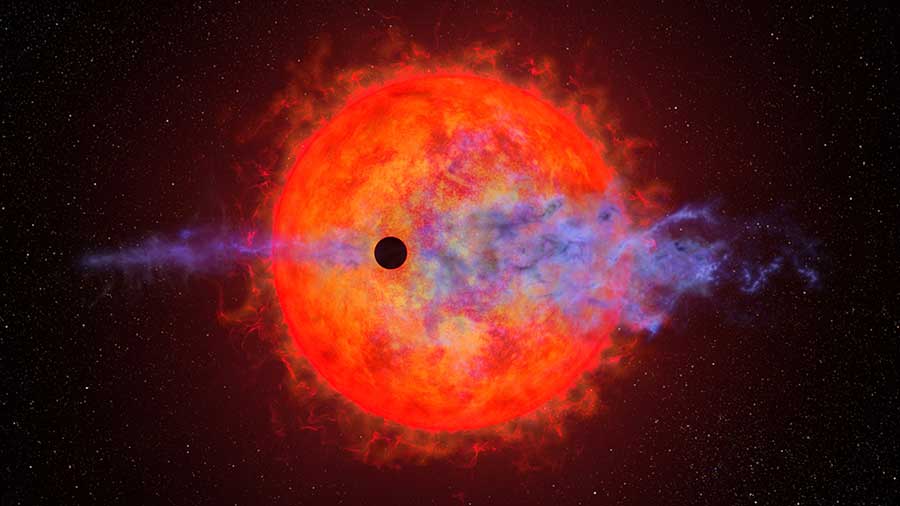Images capture the birth of stars and planets in multiple results from the James Webb Space Telescope, the Hubble Space Telescope, and the Very Large Telescope.
Webb Images the Drama of Starbirth

NASA / ESA / CSA; Image processing: Joseph DePasquale (STScI), Anton M. Koekemoer (STScI)
Some 1,400 light-years away in the southern constellation of Vela is a dark nebula dense with dust that blocks out background stars. With the James Webb Space Telescope (JWST), astronomers can see through and into this cloud (seen above in ethereal blue), revealing a pair of still-forming stars known as Herbig Haro 46/47. Discovered in 1977, Herbig-Haro 46/47 has served as one of the prototypes of this unique celestial phenomenon ever since.
The stars themselves are not visible, though the orange diffraction spikes point to their central location. A dense disk of dust and gas hides their fires. The disk isn't visible either, but its shadow is cast as two dark cones above and below the stars, seen between the spikes. While huge masses of dusty gas feed the still-growing stars, it's the paltry plasma speeding away from the center that dominates the image. The jets provide an outlet for the angular momentum of the inward-spiraling gas in the disk, so they are key both to maintaining the stars' growth and, for astronomers, to understanding it.
Read more about the image from the JWST press release.
New Image Reveals Planet Beginnings

In 2014, the young star V960 Monoceros began flaring, brightening by a factor of 20. That light has revealed the first stages of planet birth in this system, and it wasn't what astronomers were expecting.
A commonly accepted idea for how planets form is core accretion: Asteroid-size objects bump and glom together to form larger planetesimals, which then gather gas around them. In this scenario planets take tens of millions of years to form. However, it could be planets instead come together via gravitational instability, in which material in a disk collapses suddenly. The latter would happen much more quickly, forming gas giants over thousands of years.
While theoretical calculations have favored core accretion, V960 Mon gives observational favor to instability. Astronomers watched the system shortly after the star's flare in 2014 using the Spectro-Polarimetric High-contrast Exoplanet Research (SPHERE) instrument on the Very Large Telescope in Chile. SPHERE revealed spiral arms surrounding the young star.
Philipp Weber (University of Santiago, Chile) and colleagues recently dug into the archive of the Atacama Large Millimeter/submillimeter Array. ALMA's longer wavelengths can delve deeper into the system, probing areas of denser dust. The ALMA images show that within the spiral arms, dusty mass is collapsing into planet-mass clumps.
“No one had ever seen a real observation of gravitational instability happening at planetary scales — until now,” says Weber.
Read more in the Astrophysical Journal Letters and in the European Southern Observatory's press release.
Young Neptune Is Losing Its Air

NASA / ESA / Joseph Olmsted (STScI)
AU Microscopii b is a Neptune-size planet that orbits its 23 million-year-old red dwarf star every 8.5 days. That's searingly close for a gaseous giant, even considering its little host; for all its small size, the star is also actively flaring, as young red dwarfs are wont to be. So it's not surprising that new Hubble Space Telescope data show the planet enveloped in a cloud of escaping neutral hydrogen gas. What's puzzling is that the cloud appears largely ahead of the planet in its orbit.
The Transiting Exoplanet Survey Satellite (TESS) detected AU Mic b as it passed across the face of its star. Thanks to its transits, astronomers can also detect the spectroscopic signature of escaping gas. Interestingly, the first Hubble view of AU Mic b showed no escaping hydrogen. The second view, a year and a half later, showed lots of escaping gas. Moreover, that gas was leading the planet in its orbit.
The extreme variability in atmospheric loss might have come about because a stellar flare a few hours prior to the first observation ionized the gas, rendering it invisible to the method by which Hubble was observing it. Another explanation is that the stellar wind itself is shaping the planetary outflow. In the end, this gradual loss of atmosphere will likely leave only a barren core behind.
"This frankly strange observation is kind of a stress-test case for the modeling and the physics about planetary evolution," says Keighley Rockcliffe (Dartmouth College). "This observation is so cool because we're getting to probe this interplay between the star and the planet that is really at the most extreme."
Read more in the Astronomical Journal and in NASA's press release.
 0
0









Comments
You must be logged in to post a comment.